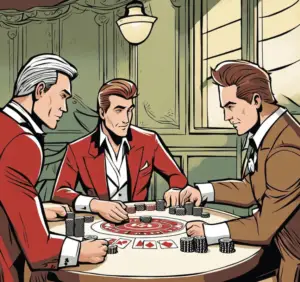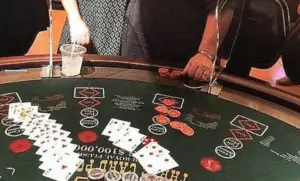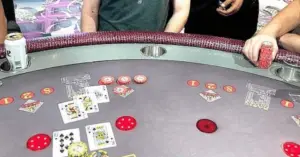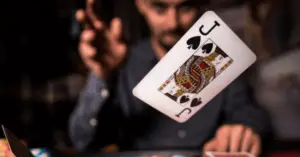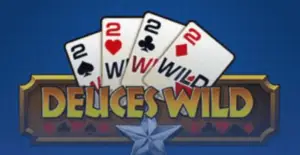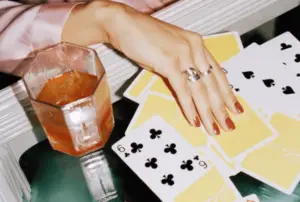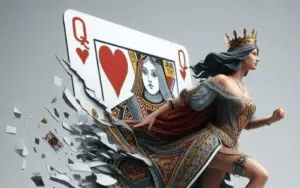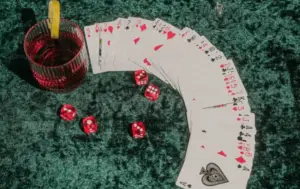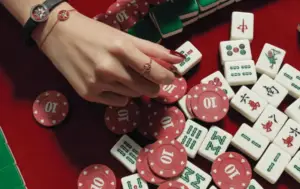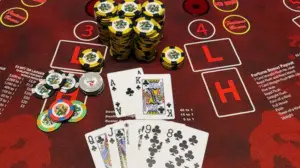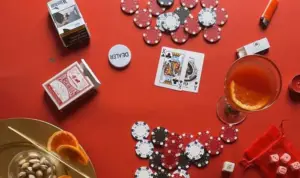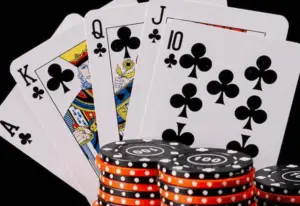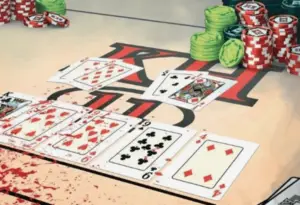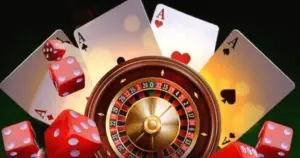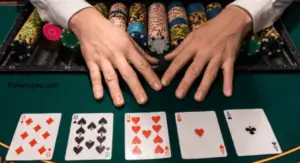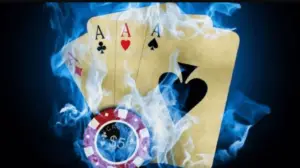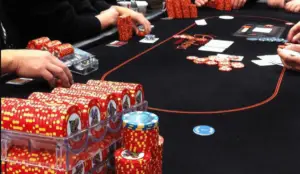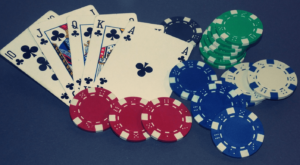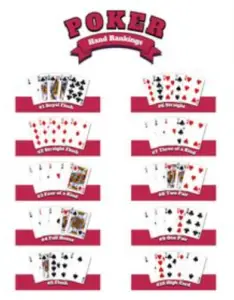Ace-to-Five Triple Draw Lowball, or A-5 Triple Draw, is a lowball poker variant that’s gaining traction in both cash games and tournaments. It’s a lowball game, meaning the lowest hand wins.
The best hand is A-2-3-4-5, also called the wheel. What makes A-5 Triple Draw unique is that straights and flushes don’t count against you.
This game is simpler than other lowball variants like 2-7 Triple Draw, where the best hand is 2-3-4-5-7. In A-5, players get three chances to draw new cards, trying to make the lowest five-card hand possible.
It’s become a hit in mixed game formats and is often played in high-stakes cash games in Las Vegas and online. While not as popular as Texas Hold’em, A-5 Triple Draw is loved by pros for its strategic depth and fast-paced action.
Rules of the Game
A-5 Triple Draw is a fun poker game that’s easy to learn but tough to master. Let’s break down how to play:
Deck and Player Setup
The game uses a standard 52-card deck and can be played with 2 to 6 players. Each player gets five cards to start. Just like in other poker games, there’s a dealer button that moves clockwise after each hand.
Betting Structure and Rounds
A-5 Triple Draw usually uses a fixed-limit betting structure. There are four betting rounds in total:
- Before the first draw
- After the first draw
- After the second draw
- After the third draw
The game starts with two blinds: the small blind and the big blind. In a typical game, bets in the first two rounds are at the lower limit, while bets in the last two rounds are at the higher limit. For example, in a $4/$8 game, bets and raises are $4 in the first two rounds and $8 in the last two.
Drawing Phases
What makes this game special is the three drawing phases. After each betting round (except the last), players can discard and draw new cards. Here’s how it works:
Players choose which cards to keep and which to throw away.
Starting with the player left of the dealer, each player says how many cards they want to draw.
The dealer gives each player their new cards.
You can draw anywhere from zero to five cards each time. If you don’t want any new cards, you can “stand pat“.
Hand Rankings and the “Wheel”
In A-5 Triple Draw, the goal is to make the lowest hand possible. The best hand is called the “wheel” – it’s A-2-3-4-5. Here’s a quick rundown of hand rankings from best to worst:
- A-2-3-4-5 (the wheel)
- A-2-3-4-6
- A-2-3-5-6
- A-2-4-5-6
- A-3-4-5-6
- 2-3-4-5-6
Remember, straights and flushes don’t count against you in this game. So, a hand like A-2-3-4-5 of the same suit is still the best possible hand. One tricky thing to remember: Aces are always low in this game. So, a hand like A-A-2-3-4 is actually worse than 2-3-4-5-6.
Here’s a cool fact: You’ll only get dealt a pat wheel(A-2-3-4-5 right off the bat) about 0.24% of the time. That’s less than 1 in 400 han
How to Play Ace-to-Five Triple Draw?
Let’s dive into how a hand of Ace-to-Five Triple Draw unfolds. This game is a real nail-biter, with lots of chances to improve your hand!
Blinds and Initial Dealing
The game kicks off with blinds, just like in Texas Hold’em. The player to the left of the dealer button posts the small blind, and the next player posts the big blind.
These forced bets get the pot started. Next, each player gets five cards face down. This is where the fun begins! You’ll want to peek at your cards and start planning your strategy.
First Betting Round
Now it’s time to put your poker face on. The action starts with the player to the left of the big blind. They have three options:
Call (match the big blind)
Raise (increase the bet)
Fold (give up their hand)
The action continues clockwise around the table. Each player must at least call the big blind to stay in the hand. If there’s a raise, everyone needs to match it or fold.
Here’s a cool fact: In a typical $4/$8 game, the small blind might be $2 and the big blind $4. Bets and raises in this first round would be $4.
Three Drawing Phases
This is where Ace-to-Five Triple Draw really shines. You get not one, not two, but three chances to improve your hand!
First Draw:
After the first betting round, players can discard cards they don’t want and get new ones. You can swap out anywhere from zero to all five cards. If you like your hand, you can “stand pat” (keep all your cards). The action starts with the first active player to the left of the button. They’ll say how many cards they want, and the dealer will give them that many new cards.
Second Betting Round and Draw:
After everyone’s had a chance to draw, there’s another betting round. This follows the same pattern as the first, but now players have more info about what others might be holding. Then comes the second draw. Same deal as before – discard and draw new cards if you want.
Third Betting Round and Draw:
You guessed it – another betting round, followed by one last chance to improve your hand.
Final Betting and Showdown
After the third draw, there’s one last betting round. This is where things get serious! In our $4/$8 game example, bets and raises in this final round would be $8.If there’s more than one player left after the final betting, it’s time for the showdown.
Everyone still in the hand reveals their cards, and the lowest hand wins!
Example Hand
Let’s walk through a quick example:
Player A (small blind): A-7-8-9-Q
Player B (big blind): 2-3-4-6-K
Player C (button): A-2-5-7-9
First betting round: Everyone calls.First draw:
Player A draws 4 cards (keeps the Ace)
Player B draws 1 card (keeps 2-3-4-6)
Player C draws 2 cards (keeps A-2-5)
Second betting round: Player A bets, B and C call.Second draw:
Player A draws 2 cards
Player B stands pat
Player C draws 1 card
Third betting round: Player B bets (representing a strong hand), A folds, C calls.Third draw:
Player B stands pat again
Player C draws 1 card
Final betting round: B bets, C calls.Showdown:
Player B shows 2-3-4-6-8
Player C shows A-2-3-5-7
Player C wins with a better low hand!
Hand Rankings in A-5 Triple Draw
In Ace-to-Five Triple Draw, the goal is to make the lowest hand possible. Let’s break down how hands are ranked in this exciting poker variant.
Best Possible Hands
The cream of the crop in A-5 Triple Draw is the “wheel” – that’s A-2-3-4-5. This unbeatable hand is what everyone’s gunning for. After the wheel, hands are ranked from lowest to highest, with aces always counting as low. Here’s a quick rundown of some top-notch hands:
- A-2-3-4-5 (the wheel)
- A-2-3-4-6
- A-2-3-5-6
- A-2-4-5-6
Straights and Flushes Don’t Count
Here’s where A-5 Triple Draw throws you a curveball: straights and flushes don’t count against you. This means A-2-3-4-5 of the same suit is still the best hand possible. It’s like getting a royal flush in regular poker!
Examples of Strong and Weak Hands
Strong hands in A-5 Triple Draw are those with low cards and no pairs. For instance:
- A-2-3-4-7
- A-2-3-5-8
- 2-3-4-5-7
These hands are tough to beat and will often win you the pot. On the flip side, weak hands include:
Any hand with a pair (like 2-2-3-4-5)
High card hands (like 7-8-9-T-J)
Hands with multiple high cards (like A-2-8-9-T)
Remember, in this game, even a hand like K-Q-J-T-9 is a real stinker! You’d be better off with almost anything else. A cool fact: The odds of being dealt the wheel (A-2-3-4-5) right off the bat are about 0.24%. That’s less than 1 in 400 hands! So if you snag one, count yourself lucky and bet big!
Winning Strategies and Tips
Come along with me as I explore some killer strategies for Ace-to-Five Triple Draw. No matter your level, these tips will help you improve!
1. Pre-Draw Strategy
Starting Hand Selection
In A-5 Triple Draw, your starting hand is crucial. Look for low cards, especially those that could make a wheel (A-2-3-4-5). Here are some solid starting hands:
- A-2-3-4-x
- A-2-3-5-x
- 2-3-4-5-x
Hands with three cards 5 or lower are usually worth playing. But be careful with hands like A-6-7-8-9 – they might look tempting, but they’re trouble!
Position-Based Play
The position is king in A-5 Triple Draw. When you’re on the button (last to act), you’ve got a big edge. You can see what everyone else does before making your move. In early position, play tighter. On the button, you can loosen up a bit.
Aggressive Play and Re-raising
Don’t be a wallflower! Aggressive play often pays off in A-5 Triple Draw. If you’ve got a strong hand, don’t be afraid to raise or re-raise. This can help you thin the field and build the pot when you’ve got the goods.
2. Drawing Strategy
When to Draw and How Many Cards
Your drawing strategy depends on your hand and position. Here’s a quick guide:
With one or two cards to a wheel, draw three or four.
With three low cards, draw two.
With four low cards, draw one.
With a made hand (like 7-6-4-3-2), consider standing pat.
Remember, drawing aggressively is often the way to go. Don’t be scared to draw three or even four cards if you’re chasing a strong low hand.
Pat Hands vs. Drawing Hands
A pat hand is one you don’t draw to – you keep all five cards. In A-5 Triple Draw, a good pat hand might be 7-6-4-3-2 or better. But be careful! Sometimes it’s better to break up a mediocre pat hand and draw for a better one.
Observing Opponents’ Drawing Behavior
Keep your eyes peeled! If an opponent draws one card, they might have four to a good low. If they stand pat, they could have a strong hand – or they might be bluffing. Use this info to guide your play.
3. Post-Draw Strategy
Betting Patterns Based on Hand Strength
After the draw, your betting should reflect your hand strength. Got a monster like 5-4-3-2-A? Bet big! Do you have a marginal hand like 8-7-6-4-2? Maybe check and call.
Check-raising and Bluffing
Check-raising can be a powerful move, especially if you’ve got the nuts. And don’t forget about bluffing! Sometimes, a well-timed bluff can win you the pot, even with a mediocre hand.
Playing Marginal Hands
Hands like 8-7-6-5-3 are tricky. They’re not great, but not terrible either. In late position, these hands can be worth a bet, especially if your opponents seem weak.
4. Advanced Concepts
Snowballing (Bluffing by Standing Pat)
Snowballing is when you stand pat (don’t draw any cards) as a bluff. It’s a gutsy move that can make your opponents think you’ve got a killer hand. Use this sparingly, but when it works, it’s sweet!
Break Points for Pat Hands
Every player has a break point – the point at which they’ll draw to try and improve their pat hand. For many players, this is around 8-7-6-5-4. Knowing your opponents’ break points can give you an edge.
Multi-way Pot Considerations
In multi-way pots (pots with three or more players), be extra cautious. Your hand needs to be stronger to win, so adjust your strategy accordingly. Don’t be afraid to fold if you think you’re beat.
Example Hand
Let’s walk through a hand to see these strategies in action:You’re on the button with A-2-5-7-9. Not bad! You raise, and two players call. In the first draw, you keep A-2-5 and draw two. You get a 3 and a 6. Nice!You bet, one player folds, the other calls.
In the second draw, you keep A-2-3-5 and draw one. You get a 4. Bingo! You’ve hit the wheel!You bet big, your opponent calls. In the final draw, you stand pat (of course!). Your opponent draws one.
You bet, they call. You show your wheel and scoop the pot!Remember, A-5 Triple Draw is all about reading your opponents, making smart draws, and sometimes taking calculated risks. With practice, you’ll be crushing the game in no time!
Common Mistakes to Avoid
Even seasoned poker players can slip up in Ace-to-Five Triple Draw. Let’s look at some common blunders and how to dodge them.
Overvaluing Certain Starting Hands
Don’t get starry-eyed over hands that look good but aren’t! Many players fall into the trap of overplaying hands like A-6-7-8-9. Sure, you’ve got an ace, but the rest of your hand is junk.Instead, focus on hands with low cards that can make a wheel (A-2-3-4-5). A hand like 2-3-4-5-7 is way better than A-K-Q-J-T in this game.
Misplaying Draws
Drawing too many or too few cards is a rookie mistake. If you’ve got three low cards, don’t be scared to draw two. But if you’re heads-up (against one opponent), drawing one might be smarter.
Remember, in A-5 Triple Draw, aggressive drawing often pays off. Don’t be shy about ditching three or four cards if you’re chasing a strong low hand.
Failing to Adjust to Opponents’ Tendencies
This is a biggie! If you’re not paying attention to how your opponents play, you’re leaving money on the table.Watch how many cards they draw.
If someone’s always standing pat (not drawing), they might be bluffing more than you think. On the flip side, if a player’s constantly drawing three or four cards, they might be playing too loose.
Also, keep an eye on betting patterns. If a player always bets big with strong hands and checks weak ones, use that info to your advantage!By avoiding these common mistakes, you’ll be well on your way to crushing A-5 Triple Draw. Keep your wits about you, play smart, and may the lowest hand win!
Tournament vs. Cash Game Strategy
Poker tournaments and cash games require different strategies. Let’s break it down:
Adjusting Play for Tournament Formats
In tournaments, you need to adapt as blinds increase and antes come into play. As the tourney progresses, you’ll need to play more aggressively to stay ahead of the rising blinds. In cash games, the blinds stay the same, so you can be more patient.
Stack Size Considerations
Your stack size is crucial in tournaments. With a big stack, you can put pressure on smaller stacks. When you’re short-stacked, you might need to shove all-in more often. In cash games, you can always rebuy, so stack size is less of a factor.
Bubble Play and Final Table Dynamics
The bubble (when players are close to making the money) is a unique tournament situation. Tight players might let you steal their blinds more often.
At the final table, pay attention to ICM (Independent Chip Model) considerations.Remember, in tournaments, you’re playing for survival and ladder-ups. In cash games, every hand is a separate event. Adjust your strategy accordingly, and you’ll crush both formats!
A-5 Triple Draw in Mixed Games
A-5 Triple Draw isn’t typically part of the classic H.O.R.S.E. mix, but it does show up in other mixed game formats.
You might see it in the $2,500 Mixed Triple Draw event at the World Series of Poker, where it’s played alongside 2-7 Triple Draw and Badugi.When switching to A-5 from other games, you’ve gotta adjust your thinking.
In Texas Hold’em or Omaha, you’re gunning for high hands. But in A-5, you want the lowest hand possible. The wheel (A-2-3-4-5) is the nuts here.Remember, straights and flushes don’t count against you in A-5. This means you can keep more cards when drawing.
For example, if you’ve got A-2-3-4-8, you can just draw one card instead of two.Another key difference is how you play pairs. In 2-7 Triple Draw, a pair of deuces isn’t bad. But in A-5, any pair is a bummer.
You’ll want to break those up and draw for better low cards.Lastly, keep an eye on your opponents’ drawing habits. If they’re drawing fewer cards than in 2-7, they might have a strong A-5 hand brewing!
Conclusion
A-5 Triple Draw is a real gem in the poker world. It’s got a unique flavor that keeps players coming back for more. The thrill of chasing the wheel (A-2-3-4-5) and the strategic depth make it a hit in mixed games.
To get good at A-5, you’ve gotta put in the hours. Practice makes perfect, as they say. Try playing online at sites like 888poker or PokerStars to hone your skills.
For more learning, check out Daniel Negreanu’s chapter in “Super System 2” or watch strategy videos on YouTube. With some elbow grease and a bit of luck, you’ll be crushing A-5 Triple Draw in no time!

